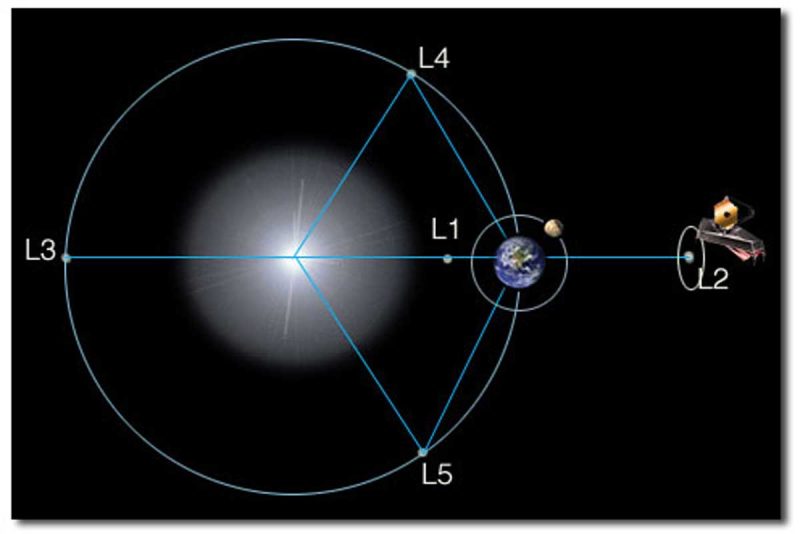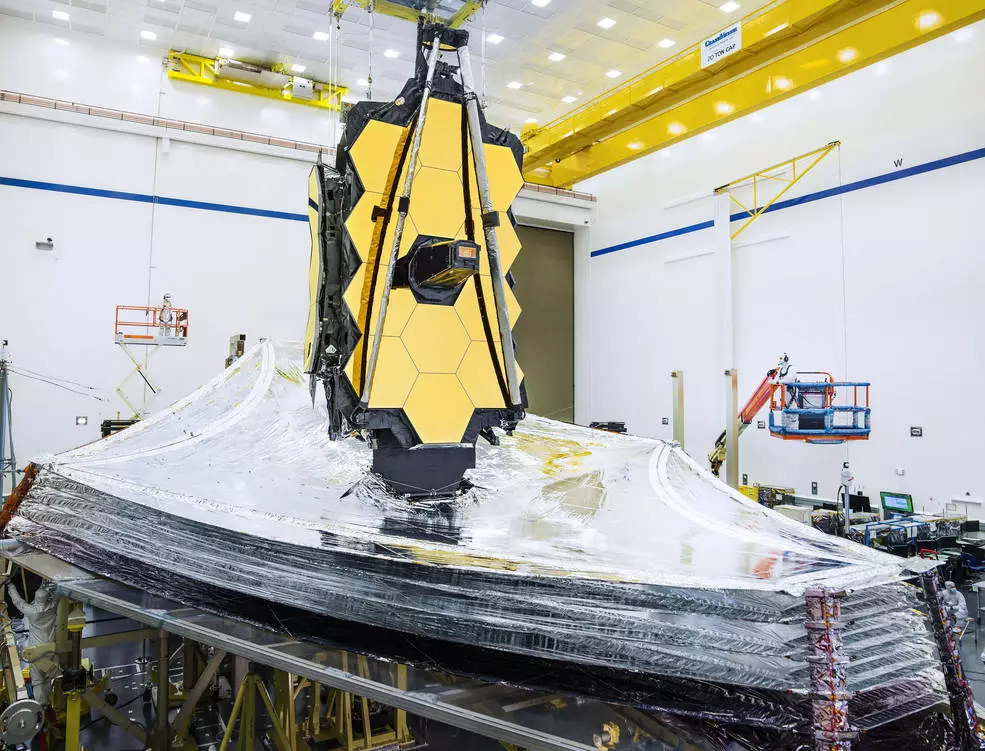Last Updated on January 6, 2022 by teamyantragyan
Unimaginable would be the word to perfectly describe this quest. We are talking about the largest and the most powerful space telescope, ‘The James Webb space telescope’. Ten billion dollars to reach 1 million miles through the eyes of a 21 feet (6.5 meters) gold mirror.
let’s talk about James Webb Space Telescope.
What is James Webb Space Telescope?
James Webb’s space telescope is an engineering marvel and the closest thing to the time machine that we have today. From planets to stars to nebulae to galaxies and beyond, it can observe almost the whole cosmos. It will help to solve the mysteries in our solar system, can explore distant worlds nearby other stars, and we can search for the origins of the universe.

When did it all started?
JWST originated in 1996 when a panel of astronomers was attempting to plan the successor of the Hubble space telescope and Spitzer Space Telescope. Earlier it was known by the name of Next-generation space telescope (NGST). It was originally planned to launch in 2007 with a massive budget of US $500 million.
In 2002, after further development of the design, ‘The James Webb telescope’ was renamed after the man who led NASA in the 1960s, NASA’s second administrator James E Webb. The man behind Apollo’s mission now looking for the secrets of the universe. A feat that you and I would never in a million years even dream of.
But the journey of this super telescope is not smooth at all. In 2005 it went through a major redesign which contributed to one of the many reasons for the delay of its launch like the ripped sunshield during its deployment, issues with the Ariane 5 rocket and the telescope itself, and communications issues between the telescope and the launch vehicle.
Beginning of the million mile Journey
Construction of this glorious time machine was completed in 2016 after which an extensive testing phase began. JWST launched on December 25, 2021 07:20am EST ( 2021-12-25 12:20 GMT/UTC).
The launch took place in Kourou, French Guiana on South America’s northeastern coast, where the observatory rode a European Ariane 5 rocket into the morning sky and was released from the upper stage 27 minutes later. Its destination of 1 million miles or 1.6 million kilometers will take a month to reach and another 5 months for its infra-red eyes to start scanning the cosmos.

Launch vehicle
The James Webb space telescope was launched into its orbit using the Ariane 5 rocket which was a European contribution to the mission. With the Ariane 5, Webb can reach its destination in space with one of the most reliable launch vehicles in the world. The European Space Agency (ESA) has agreed to provide an Ariane 5 launcher and associated launch services to NASA for Webb.

After 14 years of delays and a ballooning price tag that, at times, threatened to swallow NASA’s astrophysics budget whole, JWST has emerged as the most powerful space telescope ever built.
“JWST is a NASA flagship mission that has 10x improvements compared to all of the facilities that have come before it. As a result, JWST is expected to transform our understanding of the universe across all areas of astronomy. As with other previous missions, we expect to discover things about the universe that we hadn’t imagined before,” says Dr. Christine Chen, an associate astronomer at Space Telescope Science Institute (STScI) in Maryland, United States.
Collaborations.
After 25 years of hard work, the US space agency launched its next-generation space observatory. this project is an international collaboration between NASA, the European space agency (ESA), and the Canadian space agency (CSA). The NASA Goddard Space flight Center is managing the development effort. The main industrial partner is Northrop Grumman; the Space Telescope Science Institute will operate Webb after launch.
What makes the JWST project so special?
The breakthrough science marvel is built upon the groundbreaking discoveries of the Hubble space telescope and spitzer space telescope. In contrast to Hubble, whose telescope looks at the universe in visible light, Webb is focused on infrared light, a wavelength crucial for peering through gases and dust to see distant objects.

Innovative technology
With all the latest and hi-tech features JWST is surely keeping up with its earlier name, it is definitely the next-generation space telescope. Innovative technologies include a primary mirror made of 18 separate segments that unfold and adjust to shape after launch. The mirrors are made of ultra-lightweight beryllium to survive the micrometeoroid impact. Webb’s biggest feature is a tennis court-sized five-layer sunshield that attenuates heat from the Sun more than a million times.
JWST is designed to look into the furthest space and study the first stars and galaxies that formed in the early universe for which it must be able to detect things that are ten billion times as faint as the faintest stars visible without a telescope. This is 10 to 100 times fainter than Hubble can see.
The telescope has four instruments – cameras and spectrometers -that have detectors that are able to record extremely faint signals. The Near Infrared Camera (NIRCam) has programmable micro shutters, which enable observation of up to 100 objects simultaneously, the Near-Infrared Spectrograph (NIRSpec), the Mid-Infrared Instrument (MIRI), and the Fine Guidance Sensor/ Near InfraRed Imager and Slitless Spectrograph (FGS-NIRISS).

Webb also has a cryocooler for cooling the mid-infrared detectors of another instrument (MIRI) to a very cold 7 K so they can work. Along with it, JWST will have the coronagraphic capability, which blocks out the light of the parent star of the planets. This is needed, as the parent star will be millions of times brighter than the planets orbiting it.
One reason this telescope is so powerful is its mirror, a product that is the work of a world-class engineer. The telescope’s gigantic three-mirror anastigmat allows it to look back to the farthest reaches of the cosmos! An optical mirror of this size has never before been launched into space to survive -220°C frigid temperatures. 24 karat gold is used to coat the primary mirrors of the telescope so they reflect infrared light more clearly.
How will James Webb Space Telescope communicate with scientists at Earth?
According to NASA, the Webb will send science and engineering data to Earth using a high-frequency radio transmitter. Large radio antennas that are part of the NASA Deep Space Network will receive the signals and forward them to the Webb Science and Operation Center at the Space Telescope Science Institute in Baltimore, Maryland, USA.
Nasa administrator Bill Nelson says, “We have to realize there are still innumerable things that have to work and they have to work perfectly. But we know that in great reward, there is a great risk. And that’s what this business is all about. And that’s why we dare to explore.”
How long will the project continue?
JWST is designed to have a mission lifetime of not less than 5 and a half years after launch, with the goal of having a lifetime greater than 10 years. The lifetime is ultimately limited by the amount of fuel used for maintaining the orbit, and by proper functioning in orbit of the spacecraft and instruments.
JWST will carry fuel for a 10-year lifetime (with margin); the project will perform mission assurance testing of the flight system to guarantee 5 years of scientific operations starting at the end of the commissioning period 6 months after launch.
James Webb Space Telescope’s orbit
To maintain this environment, the telescope will orbit in deep space around Lagrange 2, or L2. It will also go through six months of commissioning in space and will be able to communicate its first images only after that.
When it reaches the L2 Point where Earth and the Sun’s gravity cancel out, JWST will keep station as its instruments cool to their working temperatures. Then, in six months, if nothing goes wrong, JWST will begin its ambitious mission to sight the first galaxies and characterize alien worlds.
Lagrange point or L2
The JWST will not be in orbit around the Earth, like the Hubble space telescope is – it will actually orbit the sun, 1.5 million kilometers (1 million miles) away from the Earth at what is called the second Lagrange point or L2.
What is special about this orbit is that it lets the telescope stay in line with the earth as it moves around the sun. this allows the satellite’s large sunshield to protect the telescope from the light and heat of the sun and earth (and Moon).

What can JWST tell us about space?
The super telescope can reveal much exciting information about space and our past. The JWST is expected to transform our understanding of the universe across all areas of astronomy. Its mission includes
- the first galaxy or the luminous objects formed after the big bang.
- evolution of the galaxies after their formation.
- observe the formation of stars from their first stages of formation to the formation of planetary system.
- measure the physical and chemical properties of planetary system, including our own solar system.
- investigate the potential for life in the planetary system.
Along with the above-mentioned mission goals, JWST will also unravel the secrets of the black hole, dark matter, and dark energy. We have a lot to learn about how galaxies got supermassive black holes in their centers, and we don’t really know whether the black holes caused the galaxies to form or vice versa.
Webb cannot directly see “dark matter,” but Webb can measure its effects. Webb will observe many statistics of galaxy evolution. Scientists can compare these observations to theories of the role that dark matter played in that process, leading to some understanding of the amount and nature of dark matter in galaxies.
Webb can observe everything in our Solar System that is further from the Sun than the Earth is. Webb’s sensitivity will be most useful in studying the faint rocky and icy objects in the far outer Solar System, including the dwarf planet Pluto and other Kuiper Belt Objects. Webb’s studies of these objects will test theories of how the Solar System formed. Webb will also observe the moons of the gas giant planets, comets, and asteroids and the planets.
Is JWST serviceable?
Hubble is in low-Earth orbit, located approximately 375 miles (600 km) away from the Earth, and is therefore readily accessible for servicing. JWST will be operated at the second Sun-Earth Lagrange point, located approximately 1 million miles (1.5 million km) away from the Earth, and will therefore be beyond the reach of any crewed vehicle currently being planned for the next decade.
In the early days of the JWST project, studies were conducted to evaluate the benefits, practicality, and cost of servicing JWST either by human space flight, by robotic missions, or by some combination such as retrieval to low-Earth orbit. Those studies concluded that the potential benefits of servicing do not offset the increases in mission complexity, mass, and cost that would be required to make JWST serviceable or to conduct the servicing mission itself.
Where does it all lead to?
The journey is off to a good start but with literally millions of things needing to go right, only time will tell how it fairs. This is by far the biggest project of all time for all those involved but the rewards are also of the same nature. The Hubble telescope has served us well with a mighty 31 years of operation. Hope the James Webb telescope follows its elder siblings’ footsteps.

Leave a Reply
You must be logged in to post a comment.